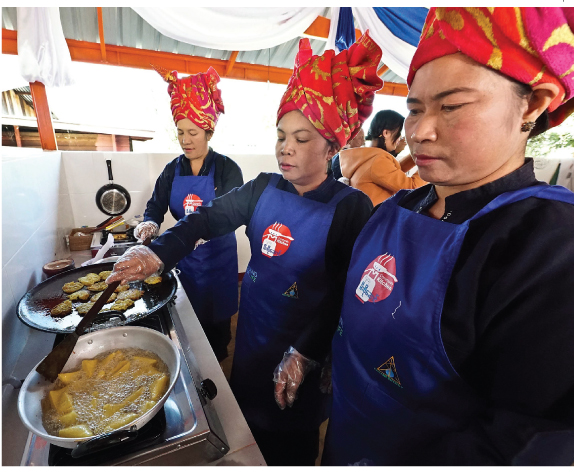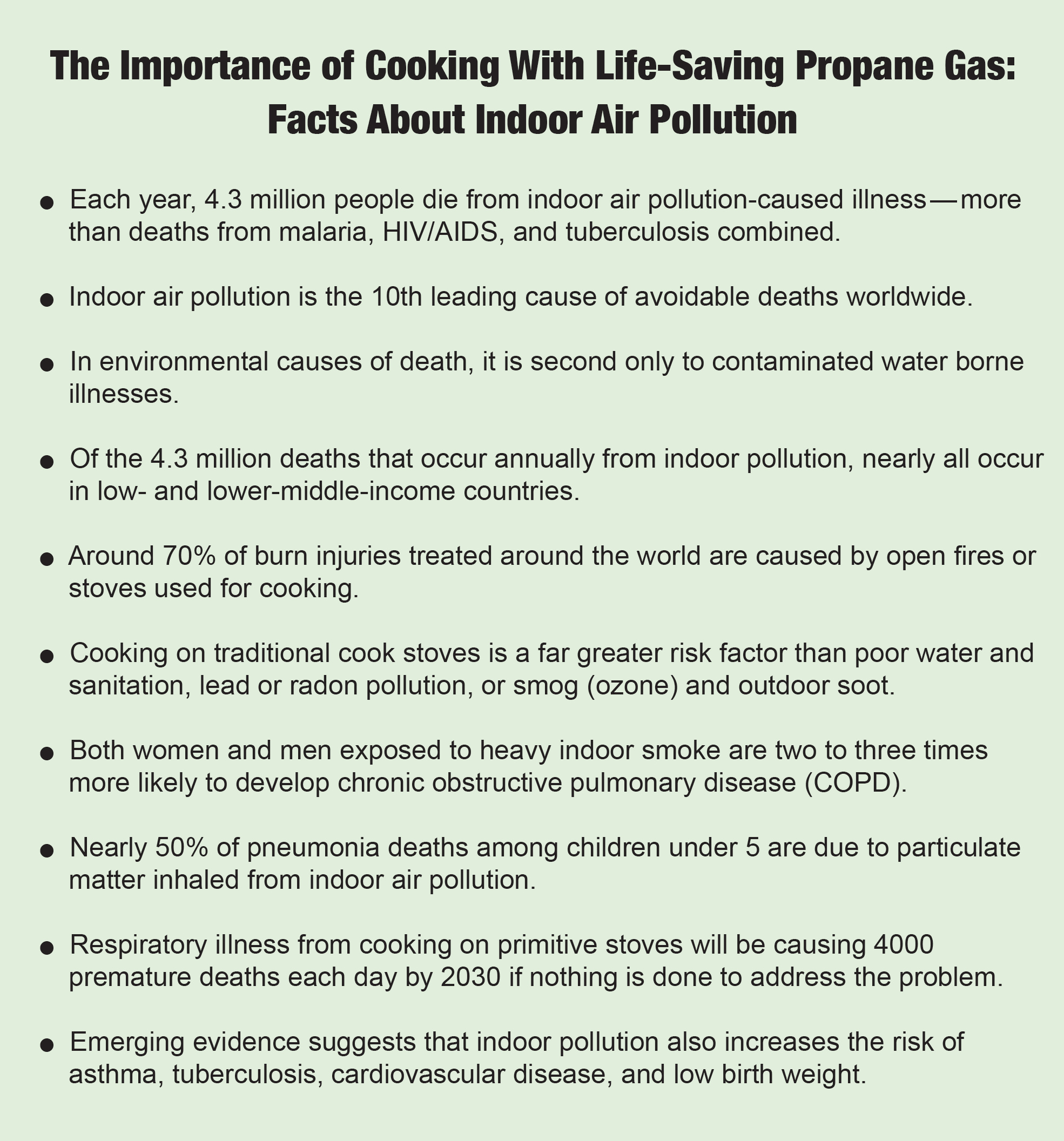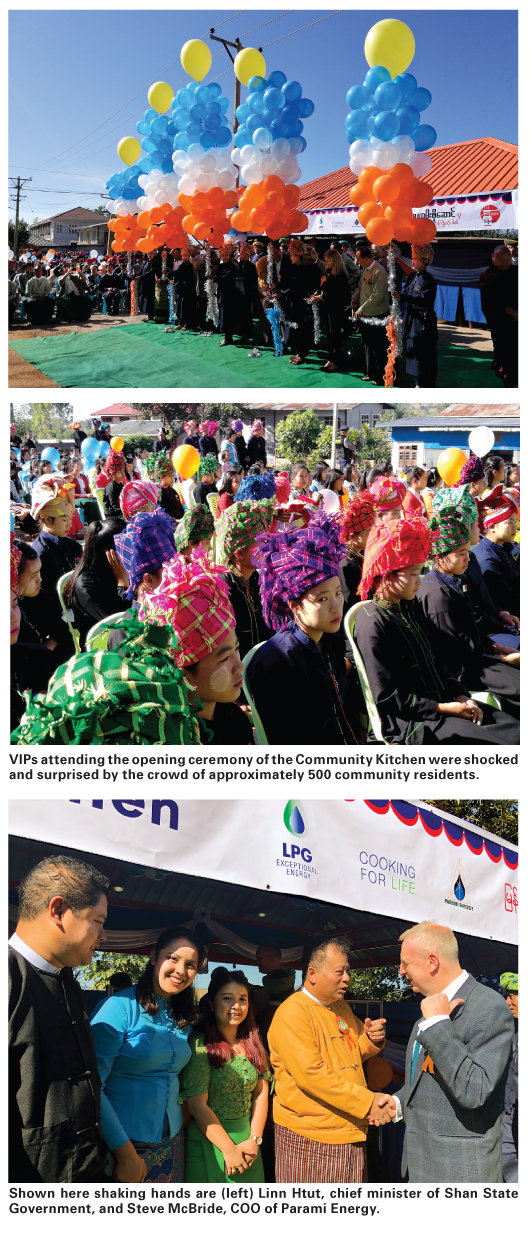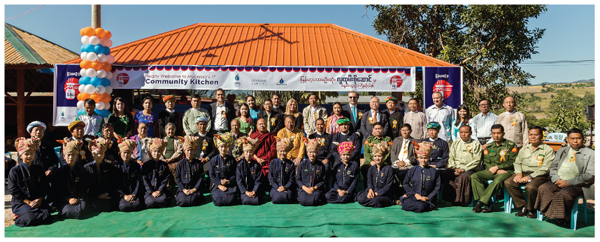Friday, January 25, 2019
Steve McBride, COO of Parami Energy, was attending a conference in Myanmar last year when he was struck by a statistic he heard from Michael Kelly, director of market development and deputy managing director for the World LPG Association (WLPGA):

Each year, 4.3 million people die from indoor air pollution-caused illness — more than deaths from malaria, HIV/AIDS, and tuberculosis combined. Indoor smoke from solid fuels is the 10th leading cause of avoidable deaths worldwide. This entirely preventable problem disproportionately affects women and children—the ones collecting, cooking with, and breathing in solid fuels. Using propane can play a significant role in combatting this staggering statistic.
It was fortuitous timing for both men. In a country where more than 80% of the 55 million residents still burn firewood and charcoal for cooking, Parami
is supporting the Myanmar government’s quest to fast-track the utilization of LPG for home cooking in 1 million households by 2020.
WLPGA is looking for partners to implement Cooking For Life, a global WLPGA campaign launched in 2012 that aims to facilitate the transition of
1 billion people from cooking with traditional fuels to cleaner-burning LPG
by 2030.
In November, less than a year after the meeting, Parami launched its first Community Kitchen, a WLPGA Cooking For Life program, in Ho Pong, the Southern Shan State in Myanmar. For the Pa’O people who dominate the Ho Pong community and others living in underdeveloped countries, a Community Kitchen is not only a major lifestyle change, but it can literally be a lifesaver.
VIPs attending the opening ceremony of the Community Kitchen included the chief ministers of Shan State and Magway region who were shocked and surprised by the crowd of approximately 500 excited community residents. “People weren’t just coming for the giveaways,” McBride said, explaining the pure joy people displayed over having their first flameless stove. “Now the minister from the Magway region wants to set up a Community Kitchen as soon as possible.”
 What is the Community Kitchen?
What is the Community Kitchen?
A Community Kitchen is generally an area with six LPG cylinders and six stove tops where cooks—usually women—take turns using the equipment. The women are taught how to cook and become familiar with cooking on a stove top. “Some Community Kitchens become centers of the communities. Communities bring in generators to charge cell phones, check the weather, and bring in TVs to watch a sport,” Kelly said.
In Ho Pong, the Community Kitchen was constructed on the grounds of a prominent monastic school and is a critical community initiative for the local community in this part of Myanmar. “Even though the Community Kitchen is 30 feet by 15 feet, it’s not particularly big, but in a community like that you start building the structure and people say, ‘What’s going on?’” McBride said. “Our CEO has been a philanthropist. He has contributed to salaries in about 1600 schools [primarily run by monks] in Myanmar. The monk in this particular village is one of the most popular senior community leaders in Shan State and indeed nationwide. The Community Kitchen was built on land adjacent to the monastery.
“The monk assigned people to look after it. There’s a small subset of people who have access to the keys,” he said. “People [in the community] are very trustworthy, but it’s the people coming through from other areas we worry about.”
The assigned villagers also notify Parami when the cylinders are running low. Transporting the gas is more expensive than the gas itself, McBride said, since it takes about 12 to 15 hours to transport it from Parami’s terminal to the Community Kitchen.
Parami is donating the gas and not charging participants to use the Community Kitchen, McBride explained. “The real objective is try and make people understand propane gas is a healthy cooking source. Gas is a safe source. When they see the propane gas cylinders, they think gas is dangerous. It’s one of the things we need to do to educate people. The more they see this, the more they become aware LPG is safe.”
In many underdeveloped countries, LPG tanks are not filled safely and are often only partially filled, Kelly said. Through WLPGA initiatives, people in underdeveloped countries are now associating red cylinders involved in the initiatives as safe cylinders. In some communities, owning a red cylinder has become a status symbol.
About Cooking For Life
The Community Kitchen program is part of WLPGA’s Cooking For Life campaign that launched in 2012 and has now been implemented in three countries: India, Indonesia, and Myanmar. It convenes governments, public health officials, the energy industry, and global nongovernmental organizations (NGOs) to expand access to LPG and bring it to people who need it the most. The campaign also works to increase public awareness of how traditional fuels negatively affect everyday life among the world’s most vulnerable populations.
The goals of the program are to: One of the immediate benefits for new users of LPG cooking is having more time, said Kelly. “Across the board, the thing they liked about cylinder gas was it saved them time. Most of them cited getting more sleep. They didn’t have to get up 40 minutes before breakfast to gather wood and start a fire.”
One of the immediate benefits for new users of LPG cooking is having more time, said Kelly. “Across the board, the thing they liked about cylinder gas was it saved them time. Most of them cited getting more sleep. They didn’t have to get up 40 minutes before breakfast to gather wood and start a fire.”
WLPGA helps to promote Cooking For Life programs such as the Community Kitchen and puts the necessary tools and resources for success in the hands of energy policy decision makers in developing countries.
“We have to be conscious LPG is not a solution for the poorest of the poor,” Kelly said. The Community Kitchen, for example, is good for villages of certain sizes or neighborhoods. India, Brazil, and Indonesia are shining examples of successful countrywide conversions to LPG, proving large-scale adoption is possible.
There are a number of factors needed to make Cooking For Life successful, Kelly said.
—Karen Massman VanAsdale

Each year, 4.3 million people die from indoor air pollution-caused illness — more than deaths from malaria, HIV/AIDS, and tuberculosis combined. Indoor smoke from solid fuels is the 10th leading cause of avoidable deaths worldwide. This entirely preventable problem disproportionately affects women and children—the ones collecting, cooking with, and breathing in solid fuels. Using propane can play a significant role in combatting this staggering statistic.
It was fortuitous timing for both men. In a country where more than 80% of the 55 million residents still burn firewood and charcoal for cooking, Parami
is supporting the Myanmar government’s quest to fast-track the utilization of LPG for home cooking in 1 million households by 2020.
WLPGA is looking for partners to implement Cooking For Life, a global WLPGA campaign launched in 2012 that aims to facilitate the transition of
1 billion people from cooking with traditional fuels to cleaner-burning LPG
by 2030.
In November, less than a year after the meeting, Parami launched its first Community Kitchen, a WLPGA Cooking For Life program, in Ho Pong, the Southern Shan State in Myanmar. For the Pa’O people who dominate the Ho Pong community and others living in underdeveloped countries, a Community Kitchen is not only a major lifestyle change, but it can literally be a lifesaver.

VIPs attending the opening ceremony of the Community Kitchen included the chief ministers of Shan State and Magway region who were shocked and surprised by the crowd of approximately 500 excited community residents. “People weren’t just coming for the giveaways,” McBride said, explaining the pure joy people displayed over having their first flameless stove. “Now the minister from the Magway region wants to set up a Community Kitchen as soon as possible.”
 What is the Community Kitchen?
What is the Community Kitchen?A Community Kitchen is generally an area with six LPG cylinders and six stove tops where cooks—usually women—take turns using the equipment. The women are taught how to cook and become familiar with cooking on a stove top. “Some Community Kitchens become centers of the communities. Communities bring in generators to charge cell phones, check the weather, and bring in TVs to watch a sport,” Kelly said.
In Ho Pong, the Community Kitchen was constructed on the grounds of a prominent monastic school and is a critical community initiative for the local community in this part of Myanmar. “Even though the Community Kitchen is 30 feet by 15 feet, it’s not particularly big, but in a community like that you start building the structure and people say, ‘What’s going on?’” McBride said. “Our CEO has been a philanthropist. He has contributed to salaries in about 1600 schools [primarily run by monks] in Myanmar. The monk in this particular village is one of the most popular senior community leaders in Shan State and indeed nationwide. The Community Kitchen was built on land adjacent to the monastery.
“The monk assigned people to look after it. There’s a small subset of people who have access to the keys,” he said. “People [in the community] are very trustworthy, but it’s the people coming through from other areas we worry about.”
The assigned villagers also notify Parami when the cylinders are running low. Transporting the gas is more expensive than the gas itself, McBride said, since it takes about 12 to 15 hours to transport it from Parami’s terminal to the Community Kitchen.
Parami is donating the gas and not charging participants to use the Community Kitchen, McBride explained. “The real objective is try and make people understand propane gas is a healthy cooking source. Gas is a safe source. When they see the propane gas cylinders, they think gas is dangerous. It’s one of the things we need to do to educate people. The more they see this, the more they become aware LPG is safe.”
In many underdeveloped countries, LPG tanks are not filled safely and are often only partially filled, Kelly said. Through WLPGA initiatives, people in underdeveloped countries are now associating red cylinders involved in the initiatives as safe cylinders. In some communities, owning a red cylinder has become a status symbol.
About Cooking For Life
The Community Kitchen program is part of WLPGA’s Cooking For Life campaign that launched in 2012 and has now been implemented in three countries: India, Indonesia, and Myanmar. It convenes governments, public health officials, the energy industry, and global nongovernmental organizations (NGOs) to expand access to LPG and bring it to people who need it the most. The campaign also works to increase public awareness of how traditional fuels negatively affect everyday life among the world’s most vulnerable populations.
The goals of the program are to:
- Transition 1 billion people from cooking with traditional fuels as well as other dirty and dangerous fuels such as kerosene to cleaner-burning LPG by 2030.
- Prevent 500,000 premature deaths per year, primarily women and children, from exposure to indoor air pollution.
- Save 2.65 million hectares of forest, or 51% of annual global net deforestation, with every 268 million households converted to LPG.
 One of the immediate benefits for new users of LPG cooking is having more time, said Kelly. “Across the board, the thing they liked about cylinder gas was it saved them time. Most of them cited getting more sleep. They didn’t have to get up 40 minutes before breakfast to gather wood and start a fire.”
One of the immediate benefits for new users of LPG cooking is having more time, said Kelly. “Across the board, the thing they liked about cylinder gas was it saved them time. Most of them cited getting more sleep. They didn’t have to get up 40 minutes before breakfast to gather wood and start a fire.”WLPGA helps to promote Cooking For Life programs such as the Community Kitchen and puts the necessary tools and resources for success in the hands of energy policy decision makers in developing countries.
“We have to be conscious LPG is not a solution for the poorest of the poor,” Kelly said. The Community Kitchen, for example, is good for villages of certain sizes or neighborhoods. India, Brazil, and Indonesia are shining examples of successful countrywide conversions to LPG, proving large-scale adoption is possible.
There are a number of factors needed to make Cooking For Life successful, Kelly said.
- Political will: Both India and Indonesia had leadership who decided the initiative would happen.
- It helps to have a large population. The program does not work as well in sparsely populated areas due to the infrastructure costs of transporting the LPG. In some countries, roads are not existent, and it may take two to three days to transport cylinders.
- There should be a growing economy and a demand for the LPG industry to grow.
- There should be some structure to the industries, including companies with best practices and a global presence.
- “One of the challenges for us is we have access to all this information, but it doesn’t underscore the community’s culture,” said Kelly, who presents workshops about the program worldwide. “What happens in many ideal situations is the idea is germinating with an energy company or county. It’s a great idea of what we’d like to do and then local people latch on and run with it.
—Karen Massman VanAsdale

